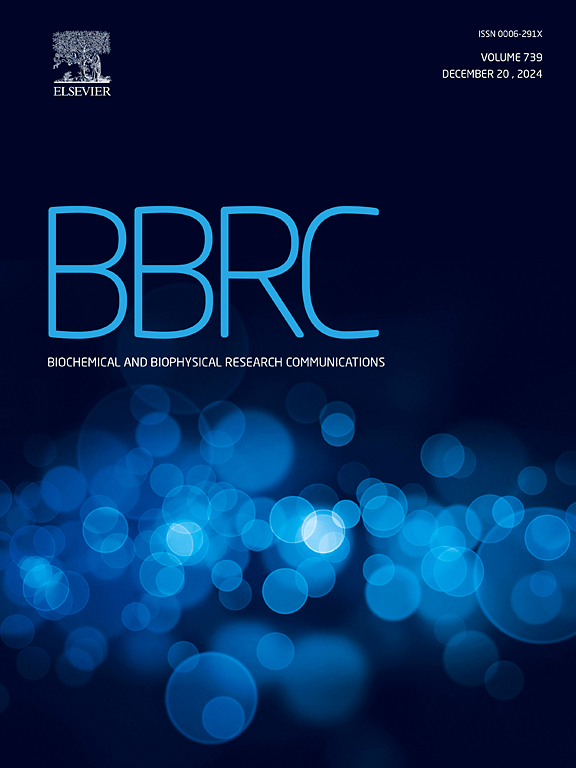五味子素A通过激活Wnt通路诱导成骨细胞分化治疗糖皮质激素所致骨质疏松
IF 2.2
3区 生物学
Q3 BIOCHEMISTRY & MOLECULAR BIOLOGY
Biochemical and biophysical research communications
Pub Date : 2025-06-18
DOI:10.1016/j.bbrc.2025.152230
引用次数: 0
摘要
五味子素A (SchA)治疗糖皮质激素性骨质疏松症(GIOP)的疗效尚不清楚,其潜在机制尚不清楚。我们建立了GIOP小鼠模型。通过显微ct分析、生物力学试验等综合评价SchA的疗效。通过转录组学分析,我们研究了SchA对GIOP小鼠骨组织中基因表达的影响。此外,采用生化试验和Western blot方法评估SchA对GIOP小鼠成骨生长相关因子的影响。为了补充这些发现,我们首先建立了成骨细胞损伤模型来验证SchA对成骨细胞分化的影响。然后,我们使用双荧光素酶试验评估了Wnt/β-catenin信号通路的活性,并进一步确定了其分子靶点。我们的研究结果表明,SchA干预显著改善了GIOP小鼠的骨量参数、骨矿物质密度、骨体积分数以及骨强度指标。SchA治疗也提高了血清钙和磷水平,减轻了股骨的病理损伤。转录组学分析显示,SchA上调了与成骨细胞分化相关的关键转录因子。Western blot分析证实,SchA干预增加了Wnt信号通路相关关键蛋白的表达。体外实验进一步验证了SchA上调成骨细胞分化因子和关键Wnt通路蛋白的作用。SchA处理后,成骨细胞的TOP/FOP闪变率明显升高,表明Wnt/β-catenin信号通路激活。然而,当使用Box5抑制Wnt5a时,SchA对成骨细胞分化的调节作用被取消。本研究综合评价了SchA对GIOP的治疗作用,认为其疗效可能与激活骨细胞Wnt信号通路,从而促进成骨细胞分化活化,促进骨形成有关。本文章由计算机程序翻译,如有差异,请以英文原文为准。
Schisandrin A induces osteoblast differentiation to treat glucocorticoid-induced osteoporosis through activating Wnt pathway
Schisandrin A (SchA) efficacy in addressing glucocorticoid-induced osteoporosis (GIOP) remains unexplored, and its underlying mechanisms are yet to be clarified. We developed a GIOP mouse model. The efficacy of SchA was assessed comprehensively through micro-CT analysis, biomechanical testing. Using transcriptomic profiling, we investigated the impact of SchA on gene expression in the bone tissue of GIOP mice. Additionally, biochemical assays and Western blot were performed to evaluate SchA's effects on osteogenic growth-related factors in GIOP mice. To complement these findings, we first established an osteoblast injury model to validate the effects of SchA on osteoblast differentiation. We then assessed the activity of the Wnt/β-catenin signaling pathway using a dual luciferase assay and further identified its molecular targets. Our findings demonstrate that SchA intervention significantly improved bone mass parameters, bone mineral density, and bone volume fraction, as well as bone strength indicators in GIOP mice. SchA treatment also elevated serum calcium and phosphorus levels and mitigated pathological damage in the femur. Transcriptomic analysis revealed that SchA upregulated key transcription factors associated with osteoblast differentiatio. Western blot analysis confirmed that SchA intervention increased the expression of key proteins involved in the Wnt signaling pathway. In vitro experiments further validated that SchA upregulated differentiation factors and key Wnt pathway proteins in osteoblasts. The TOP/FOP flash ratio in osteoblasts increased noticeably after SchA treatment, indicating activation of the Wnt/β-catenin signaling pathway. However, when Wnt5a was inhibited using Box5, the regulatory effect of SchA on osteoblast differentiation was abolished. This study comprehensively evaluates the therapeutic effects of SchA on GIOP and suggests that its efficacy likely involves activation of the Wnt signaling pathway in bone cells, thereby promoting osteoblast differentiation and activation, and facilitating bone formation.
求助全文
通过发布文献求助,成功后即可免费获取论文全文。
去求助
来源期刊
CiteScore
6.10
自引率
0.00%
发文量
1400
审稿时长
14 days
期刊介绍:
Biochemical and Biophysical Research Communications is the premier international journal devoted to the very rapid dissemination of timely and significant experimental results in diverse fields of biological research. The development of the "Breakthroughs and Views" section brings the minireview format to the journal, and issues often contain collections of special interest manuscripts. BBRC is published weekly (52 issues/year).Research Areas now include: Biochemistry; biophysics; cell biology; developmental biology; immunology
; molecular biology; neurobiology; plant biology and proteomics

 求助内容:
求助内容: 应助结果提醒方式:
应助结果提醒方式:


